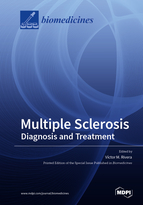Multiple Sclerosis: Diagnosis and Treatment
A special issue of Biomedicines (ISSN 2227-9059). This special issue belongs to the section "Neurobiology and Clinical Neuroscience".
Deadline for manuscript submissions: closed (31 January 2019) | Viewed by 86943
Special Issue Editor
Interests: demyelinating disorders; multiple sclerosis; epidemiology and genetic aspects; therapeutic trials
Special Issues, Collections and Topics in MDPI journals
Special Issue Information
Dear Colleagues,
Multiple Sclerosis (MS), an inflammatory demyelinating disease of the CNS, has acquired a world-wide recognition with its increasing global prevalence, including populations previously considered not to be commonly affected. Genetics and environmental factors play a determining role in its pathogenesis. Notable progress has been accomplished in diagnostic criteria (which evolve continuously) and therapeutic advances. In fact, in less than three decades, more therapies with diverse mechanisms of action (MOA) for relapsing and progressive MS have been developed for MS than for any other neurological disorder. Magnetic Resonance Imaging (MRI), the golden tool for diagnosis, is essential for monitoring the evolution of the disease and the response to therapy.
Despite this progress, substantial challenges have arisen, including the need for differential diagnosis with respect to other major inflammatory/demyelinating disorders relatively recent identification (totally different in mechanism and management), such as Neuromyelitis Optica (NMO) and Anti-MOG syndromes, and the role of environment and epigenetic factors in the mechanism of MS.
We cordially invite authors and investigators within this complex field of universal interest, to submit original research or review articles pertaining this special issue. Studies and opinions on risk factors related to the development of disease, molecular aspects of its pathogenesis, diagnostic intricacies despite current criteria, and the status of disease modifying therapies effect in relapsing and progressive forms of MS, and what is foreseen in the horizon.
Prof. Víctor M. Rivera
Guest Editor
Manuscript Submission Information
Manuscripts should be submitted online at www.mdpi.com by registering and logging in to this website. Once you are registered, click here to go to the submission form. Manuscripts can be submitted until the deadline. All submissions that pass pre-check are peer-reviewed. Accepted papers will be published continuously in the journal (as soon as accepted) and will be listed together on the special issue website. Research articles, review articles as well as short communications are invited. For planned papers, a title and short abstract (about 100 words) can be sent to the Editorial Office for announcement on this website.
Submitted manuscripts should not have been published previously, nor be under consideration for publication elsewhere (except conference proceedings papers). All manuscripts are thoroughly refereed through a single-blind peer-review process. A guide for authors and other relevant information for submission of manuscripts is available on the Instructions for Authors page. Biomedicines is an international peer-reviewed open access monthly journal published by MDPI.
Please visit the Instructions for Authors page before submitting a manuscript. The Article Processing Charge (APC) for publication in this open access journal is 2600 CHF (Swiss Francs). Submitted papers should be well formatted and use good English. Authors may use MDPI's English editing service prior to publication or during author revisions.
Keywords
- Multiple Sclerosis
- Pathogenesis
- Progressive MS
- MRI
- Monoclonal Antibodies
- Demyelinating Disorders
- Cognitive Dysfunction
- Intestinal Microbiota







